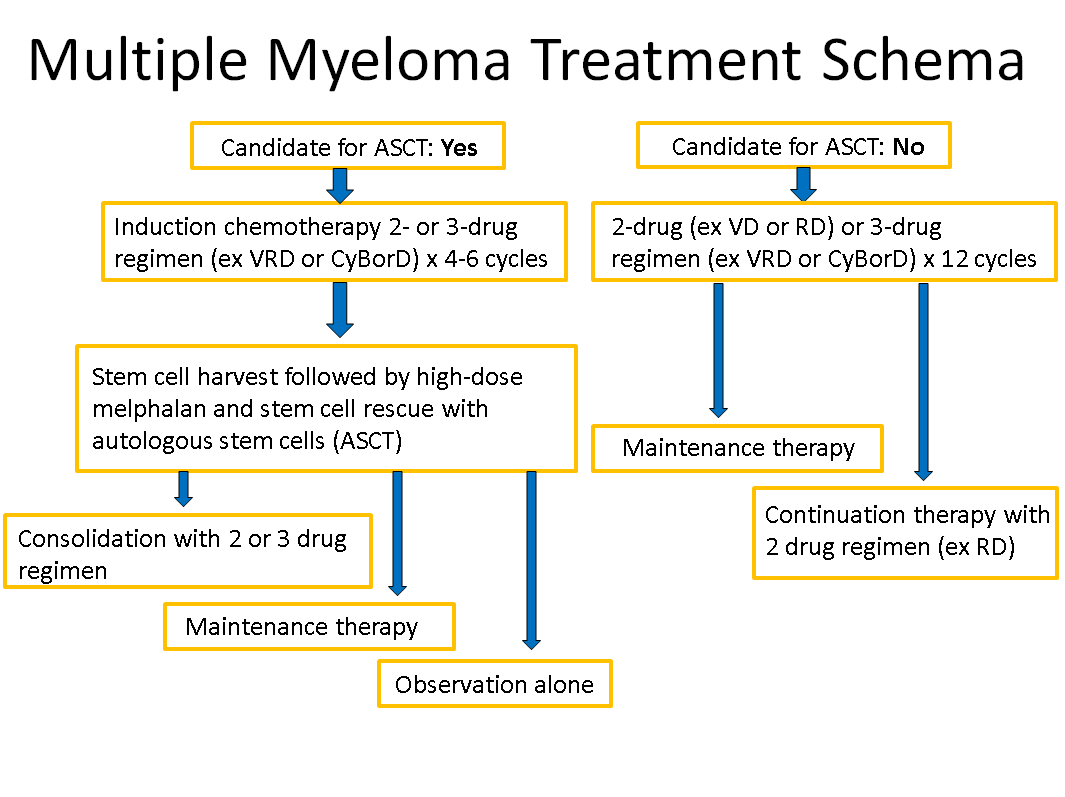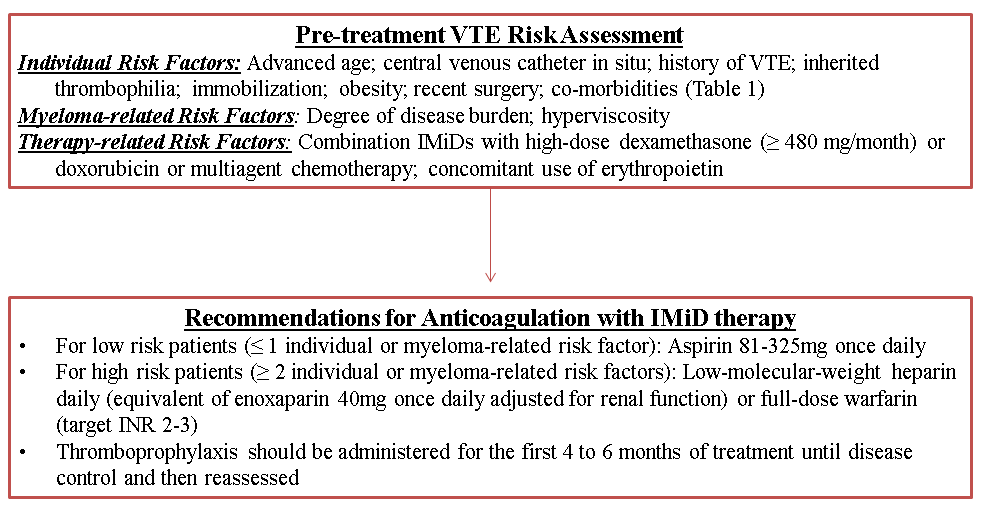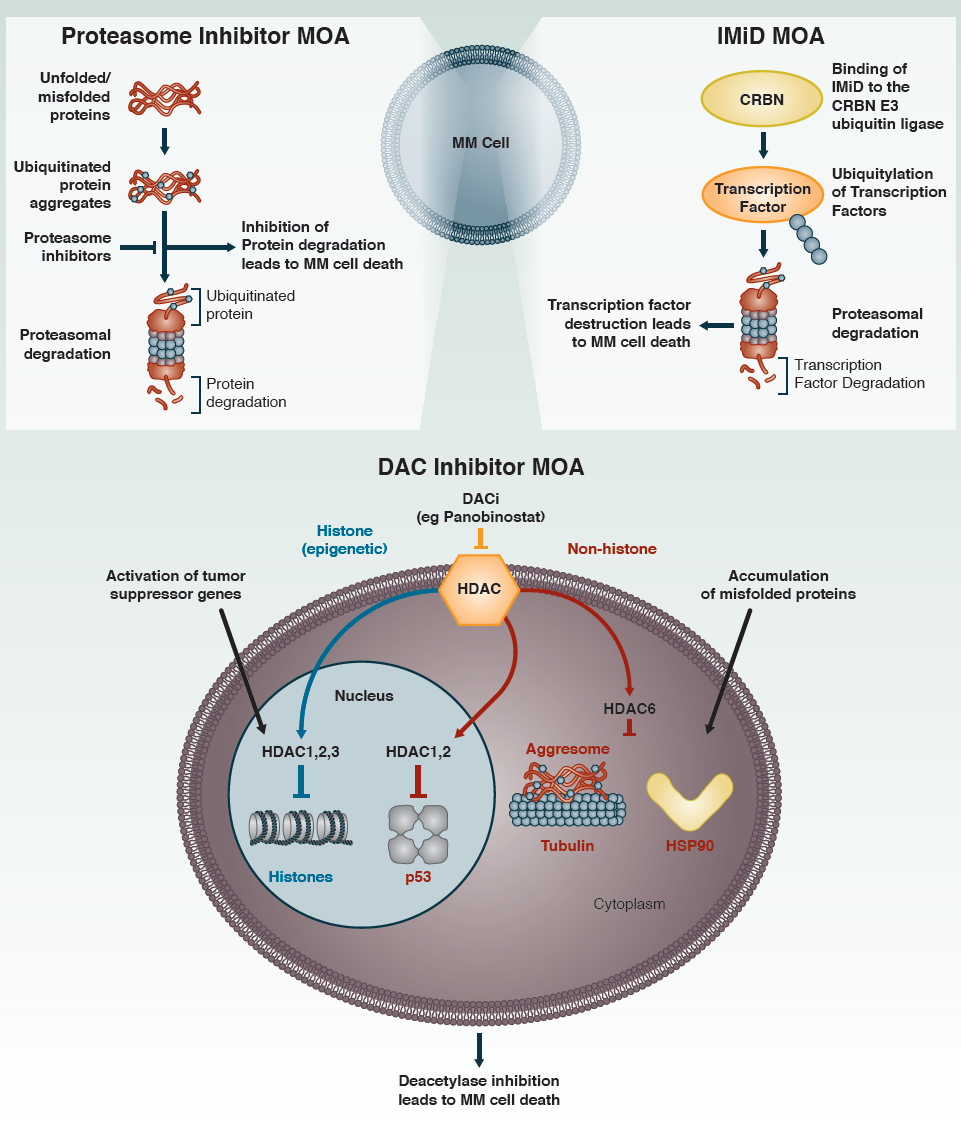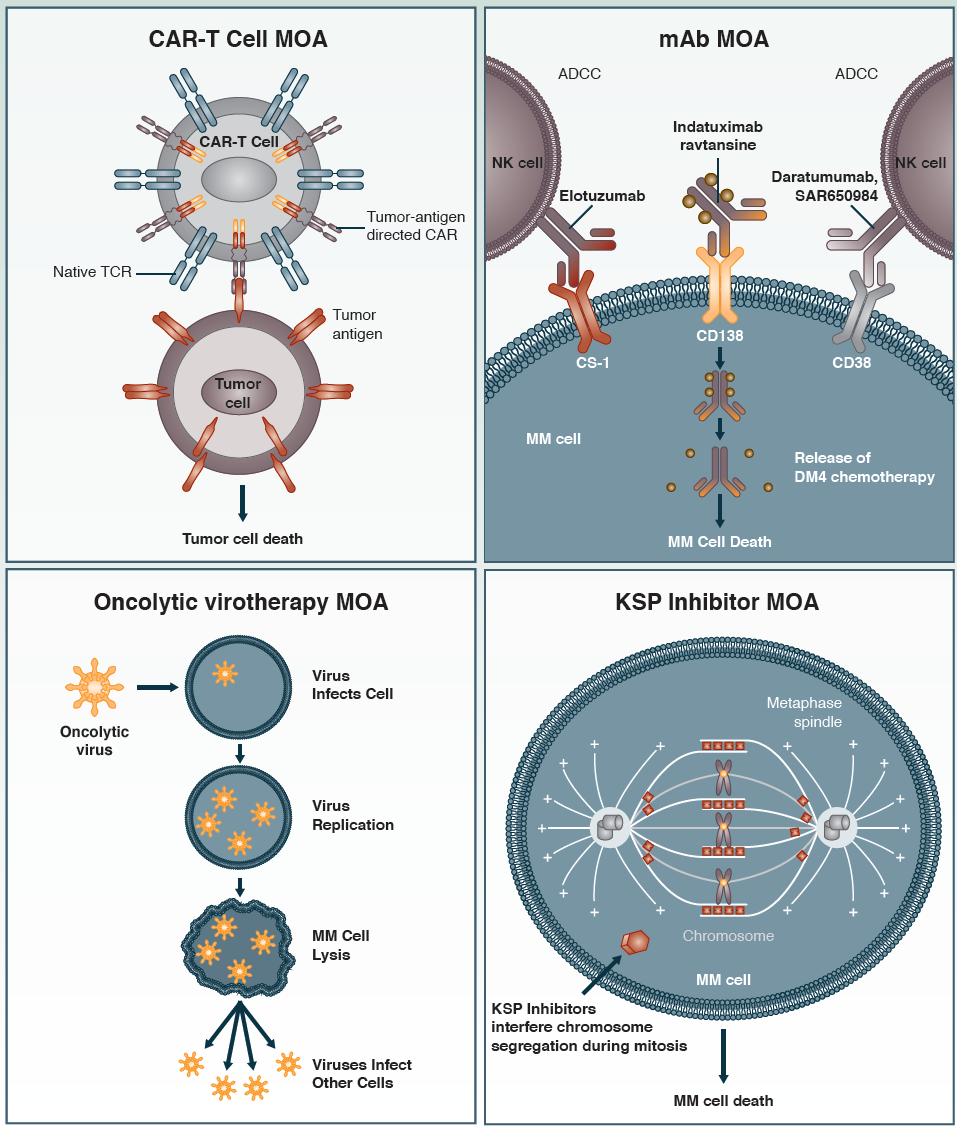Cardiac Considerations for Modern Multiple Myeloma Therapies
Introduction
Multiple myeloma is characterized by an uncontrolled proliferation of clonal plasma cells in the bone marrow. It represents 10% of hematological malignancies and is second most common after non-Hodgkin's lymphoma. Common presenting features include hypercalcemia, renal insufficiency, anemia, and lytic bone lesions. The median age of diagnosis is 69 years and is therefore a disease in older people. Due to the development of modern therapies and routine use of autologous hematopoietic cell transplantation, the median survival has improved to 5-7 years, with many patients living greater than 10 years.1 Over the past year, in fact, there were four new drugs (daratumumab, elotuzumab, ixazomib, and panobinostat) approved for treatment of relapsed and/or refractory multiple myeloma.
There are many cardiovascular (CV) considerations for patients with multiple myeloma because this population has a high prevalence of pre-existing CV comorbidities and can have increased cardiac risks from the disease burden of multiple myeloma and the treatments administered.2 For example, patients with multiple myeloma can develop chronic kidney disease or concurrent light chain amyloidosis, processes that may increase the risk of cardiac events. Weekly dexamethasone is routinely used as part of multiple myeloma treatment, and with it comes CV complications (e.g., hypertension and steroid-induced diabetes mellitus) (Table 1). Finally, due to the development of modern therapies for myeloma, patients are living longer and thus require a comprehensive longitudinal approach to managing their CV health.
Table 1: Potential CV Risk Factors in Patients With Multiple Myeloma
Coronary Artery Disease Risk Factors |
Smoking |
Family history (first degree relative: male <55 years old or female <65 years old) |
Hypertension |
Obesity |
Dyslipidemia |
Sedentary lifestyle |
Diabetes mellitus |
|
Coronary Heart Disease Risk Equivalents |
Non-coronary atherosclerotic disease |
Chronic kidney disease |
|
Myeloma-Specific Cardiac Risk Factors |
Prior anthracycline exposure |
Prior stem cell treatment |
Heavily pretreated (having received many prior lines of chemotherapy) |
Concurrent cardiac amyloid light-chain amyloidosis |
Concurrent dexamethasone treatment |
Management of Multiple Myeloma
One of the first considerations in managing patients with multiple myeloma is to determine if the patient is eligible for autologous hematopoietic cell transplantation. If institutional criteria are met (typically determined by age, renal function, and comorbidities), then standard treatment is induction chemotherapy with a combination of a proteasome inhibitor (e.g., bortezomib or carfilzomib), immunomodulatory agent (e.g., thalidomide, lenalidomide, or pomalidomide), and glucocorticosteroid (dexamethasone). The most common initial therapy choices are bortezomib + lenalidomide + dexamethasone or cyclophosphamide + bortezomib + dexamethasone. Induction therapy is given 4-6 cycles followed by autologous hematopoietic cell transplantation. Thereafter, many patients receive post-transplant therapy (also called consolidation or maintenance therapy). In patients not eligible for autologous hematopoietic cell transplantation, a prolonged course of initial chemotherapy with a doublet (bortezomib + dexamethasone or lenalidomide + dexamethasone) or triplet (bortezomib + lenalidomide + dexamethasone or cyclophosphamide + bortezomib + dexamethasone) is typically administered (Figure 1).
Figure 1
Myeloma Therapies With Known CV Risks
Therapies for multiple myeloma are extremely effective, with overall response rates approaching 100% with initial therapy.3 In general, treatments are well tolerated but do carry some specific CV-related complications.
Immunomodulatory Agents
Patients with multiple myeloma have increased mortality secondary to both arterial and venous thrombosis.4,5 Immunomodulatory agents are known to increase the risk of venous thromboembolic disease particularly when combined with dexamethasone or other chemotherapy.6 Notably, arterial thromboembolic events have also been reported with immunomodulatory agents, and lenalidomide and pomalidomide each carry a black box warning for increased risk of myocardial infarction and stroke. The detailed mechanism by which immunomodulatory agents lead to increased thromboembolic events is not established at this time. Anticoagulation is necessary in these patients unless a specific contraindication exists. The current recommendation of the International Myeloma Working Group is that patients with multiple myeloma receiving immunomodulatory agent therapy should be anticoagulated based on how high the perceived risks for thrombosis are estimated.7 For low-risk patients with ≤1 risk factor, daily aspirin is recommended. For high-risk patients with ≥2 risk factors, prophylactic low-molecular-weight heparin or therapeutic warfarin for 4-6 months is recommended and then reassessed based on ongoing risk (Figure 2). The role of newer oral anticoagulants including factor Xa inhibitors and direct thrombin inhibitors is unknown at this time.
Figure 2: Anticoagulation Recommendations for Patients Receiving Immunomodulatory Chemotherapy for Multiple Myeloma
Carfilzomib
Carfilzomib is known to be associated with an increased risk of cardiac events.8 Carfilzomib is an irreversible proteasome inhibitor currently approved by the Food and Drug Administration (FDA) for patients with relapsed and/or refractory multiple myeloma who have received at least two lines of chemotherapy. A safety analysis of phase 2 clinical trials with 526 patients with relapsed and/or refractory multiple myeloma treated with single-agent carfilzomib was notable for cardiac failure in 7.2%, ischemic heart disease in 3.4%, cardiac arrhythmia in 13.3%, hypertension in 14.3%, and pulmonary hypertension in 2%.8 Cardiac adverse events demonstrated early effect, with highest incidence associated with cycle 1 of chemotherapy. In 11.8%, these events occurred within 1 day of receiving chemotherapy. Additionally, there was a low incidence of sudden cardiac-related deaths, often occurring within 1 day of chemotherapy. Of note, carfilzomib standard dosing is 20 mg/ m2 intravenously on days 1 and 2 and then 27 mg/ m2 on days 8, 9, 15, 16, on 28-day cycles. Thereafter, 27 mg/ m2 is given on the aforementioned days. The label was recently changed to escalate dosing up to 56 mg/ m2 instead of 27mg/ m2 based on results from ENDEAVOR (Phase 3 Study With Carfilzomib and Dexamethasone Versus Bortezomib and Dexamethasone for Relapsed Multiple Myeloma Patients).9 In this study, carfilzomib + dexamethasone was superior to bortezomib + dexamethasone, demonstrating significant progression-free survival benefit in the relapsed setting. The cardiac signal, while still present, was not significantly increased despite the higher dose. A cardiac sub-study was performed as part of this trial, and the incidence of heart failure (HF), hypertension, and pulmonary hypertension were higher in the carfilzomib + dexamethasone group compared with the bortezomib + dexamethasone group (3.2 vs. 0.9%, 24.8 vs. 8.8%, and 1.3 vs. 0%, respectively).
Carfilzomib is a highly effective chemotherapeutic option for patients with myeloma. Monitoring for the development of potential cardiac events with a plan for early intervention is important for management of patients receiving carfilzomib. Our standard of care is involvement of a cardiologist prior to initiation of therapy in patients to be considered at risk for potential cardiac toxicities. This includes patients with a known history of HF, arrhythmia, pulmonary hypertension, and poorly controlled hypertension. Monitoring volume status is important with a low threshold for additional diuresis. In patients without contraindication, aspirin 81 mg is administered. Baseline B-type natriuretic peptide is measured, and transthoracic echocardiogram is obtained in select cases, both of which can serve as clinically useful points of comparison if any symptoms of volume overload develop while patients are receiving therapy. This is particularly helpful in patients with only dyspnea, which may not be cardiac in nature. In most cases, if a cardiac event occurs, temporary interruption of carfilzomib is often sufficient while managing the cardiac event. Once cardiac status is optimized, reintroduction of carfilzomib, often at the next-lowest dose level, is tolerated well by the majority of patients. However, in some cases carfilzomib is discontinued, particularly if significant HF persists despite treatment. In these cases, a diagnosis of cardiac amyloidosis should be considered.
Recently Approved Myeloma Therapies
In 2015, the FDA granted approval for ixazomib, panobinostat, daratumumab, and elotuzumab for relapsed and/or refractory multiple myeloma treatment (Figures 3A and 3B). Although in early use, there does not appear to be a strong cardiac signal associated with these therapies.
Figure 3A
Figure 3B
Ixazomib is the first oral proteasome inhibitor and is approved for use in combination with lenalidomide and dexamethasone. Approval was based on the phase 3 clinical trial TOURMALINE-MM1 (A Phase 3 Study Comparing Oral Ixazomib Plus Lenalidomide and Dexamethasone Versus Placebo Plus Lenalidomide and Dexamethasone in Adult Patients With Relapsed and/or Refractory Multiple Myeloma) data.10 Cardiac adverse events were rare, with HF incidence reported in 4% of the treatment cohort versus 3% of the control cohort.
Panobinostat is an oral histone pan-deacetylase inhibitor, recently FDA approved to be used in combination with bortezomib and dexamethasone. Approval was based on data from the phase 3 clinical trial PANORAMA-1 (Panobinostat or Placebo With Bortezomib and Dexamethasone in Patients With Relapsed Multiple Myeloma).11 Potential cardiac-related side effects were higher in the panobinostat group compared with the control group, with higher incidence of peripheral edema (29 vs. 19%), hypotension (14 vs. 9%), and dyspnea (15 vs. 12%).
Daratumumab is an IgG1κ human monoclonal antibody targeting CD38, a cell surface antigen highly expressed on myeloma cells. FDA approval was based on study data from SIRIUS (Daratumumab (HuMax®-CD38) Safety Study in Multiple Myeloma) and GEN501 (An Efficacy and Safety Study of Daratumumab in Patients With Multiple Myeloma Who Have Received at Least 3 Prior Lines of Therapy [Including a Proteasome Inhibitor (PI) and Immunomodulatory Drug (IMiD)] or Are Double Refractory to a PI and an IMiD) demonstrating an overall response rate of 31%.12,13 A significant cardiac signal has not emerged with this therapy. However, a very high proportion of patients (48%) experienced infusion-related side effects including bronchospasm, hypoxia, dyspnea, and hypertension, mostly during first-dose infusion. Patients are given pre- and post-infusion medications to minimize this risk.
Elotuzumab is an immunostimulatory monoclonal antibody targeting SLAMF7 (also called CS1) on the myeloma cell surface. This drug is also able to activate natural killer cells via SLAMF7 and Fc receptors to enhance anti-myeloma activity. It is currently FDA approved for use with lenalidomide and dexamethasone based on the phase 3 clinical trial ELOQUENT-2 (Phase III Study of Lenalidomide and Dexamethasone With or Without Elotuzumab to Treat Relapsed or Refractory Multiple Myeloma).14 In this trial, adverse cardiac events were rare, and cardiac disorders occurred with similar incidence in treatment versus control arms.
Conclusion
In recent years, rapidly evolving treatment paradigms have improved the outcomes of patients with multiple myeloma. Treatments will continue to evolve, such as with new therapies under active investigation for relapsed and/or refractory multiple myeloma including chimeric antigen T-cell therapy and bromodomain inhibitors, ensuring that we need to improve our management of CV risks and define optimal preventative strategies. Although newly developed and FDA-approved therapies have not demonstrated a major cardiac safety signal, these patients have a baseline high degree of CV comorbidities and should remain under careful surveillance. As a result, it is recommended that patients with multiple myeloma with a significant cardiac history or who develop cardiac events during therapy have early cardiology involvement to help optimize cardiac status and enhance overall outcomes.
References
- Cornell RF and Kassim AA. Evolving paradigms in the treatment of relapsed/refractory multiple myeloma: increased options and increased complexity. Bone Marrow Transplant 2016;51:479-91.
- Kistler KD, Rajangam K, Faich G, Lanes S. Cardiac event rates in patients with newly diagnosed and relapsed multiple myeloma in US clinical practice. Blood 2015;120:2916.
- Stewart AK, Richardson PG, San-Miguel JF. How I treat multiple myeloma in younger patients. Blood 2009;114:5436-43.
- Kristinsson SY, Pfeiffer RM, Bjorkholm M, et al. Arterial and venous thrombosis in monoclonal gammopathy of undetermined significance and multiple myeloma: a population-based study. Blood 2010;115:4991-8.
- Kristinsson SY, Pfeiffer RM, Bjorkholm M, Schulman S, Landgren O. Thrombosis is associated with inferior survival in multiple myeloma. Haematologica 2012;97:1603-7.
- Palumbo A, Rajkumar SV, Dimopoulos MA, et al. Prevention of thalidomide- and lenalidomide-associated thrombosis in myeloma. Leukemia 2008;22:414-23.
- Palumbo A, Rajkumar SV, San Miguel JF, et al. International Myeloma Working Group consensus statement for the management, treatment, and supportive care of patients with myeloma not eligible for standard autologous stem-cell transplantation. J Clin Oncol 2014;32:587-600.
- Siegel D, Martin T, Nooka A, et al. Integrated safety profile of single-agent carfilzomib: experience from 526 patients enrolled in 4 phase II clinical studies. Haematologica 2013;98:1753-61.
- Dimopoulos MA, Moreau P, Palumbo A, et al. Carfilzomib and dexamethasone versus bortezomib and dexamethasone for patients with relapsed or refractory multiple myeloma (ENDEAVOR): a randomised, phase 3, open-label, multicentre study. Lancet Oncol 2016;17:27-38.
- Moreau P, Masszi T, Grzasko N, et al. Ixazomib, an investigational oral proteasome inhibitor (PI), in combination with lenalidomide and dexamethasone (IRd), significantly extends progression-free survival (PFS) for patients (Pts) with relapsed and/or refractory multiple myeloma (RRMM): the phase 3 tourmaline-MM1 study (NCT01564537). Blood 2015;126:727.
- San-Miguel JF, Hungria VT, Yoon SS, et al. Panobinostat plus bortezomib and dexamethasone versus placebo plus bortezomib and dexamethasone in patients with relapsed or relapsed and refractory multiple myeloma: a multicentre, randomised, double-blind phase 3 trial. Lancet Oncol 2014;15:1195-206.
- Lokhorst HM, Plesner T, Laubach JP, et al. Targeting CD38 with daratumumab monotherapy in multiple myeloma. N Engl J Med 2015;373:1207-19.
- Lonial S, Weiss BM, Usmani SZ, et al. Daratumumab monotherapy in patients with treatment-refractory multiple myeloma (SIRIUS): an open-label, randomised, phase 2 trial. Lancet 2016;387:1551-60.
- Lonial S, Dimopoulos M, Palumbo A, et al. Elotuzumab therapy for relapsed or refractory multiple myeloma. N Engl J Med 2015;373:621-31.
Keywords: Cardiotoxicity, Amyloidosis, Anemia, Anthracyclines, Antibodies, Monoclonal, Antigens, Surface, Antimitotic Agents, Apoptosis, Arrhythmias, Cardiac, Bone Marrow, Bronchial Spasm, Cell Death, Coronary Artery Disease, Cyclophosphamide, Dexamethasone, Diabetes Mellitus, Diuresis, Dyslipidemias, Dyspnea, Edema, Factor Xa Inhibitors, Heart Failure, Hematologic Neoplasms, Heparin, Low-Molecular-Weight, Histone Deacetylase Inhibitors, Hydroxamic Acids, Hypercalcemia, Hypertension, Pulmonary, Hypertension, Hypotension, Induction Chemotherapy, Lymphoma, Non-Hodgkin, Mitosis, Multiple Myeloma, Myocardial Infarction, Obesity, Oncolytic Virotherapy, Plasma Cells, Proteasome Endopeptidase Complex, Receptors, Fc, Renal Insufficiency, Risk Factors, Smoking, Stem Cells, Stroke, T-Lymphocytes, Thalidomide, Thrombosis, Ubiquitin, Ubiquitin-Protein Ligases, Venous Thrombosis, Warfarin
< Back to Listings




